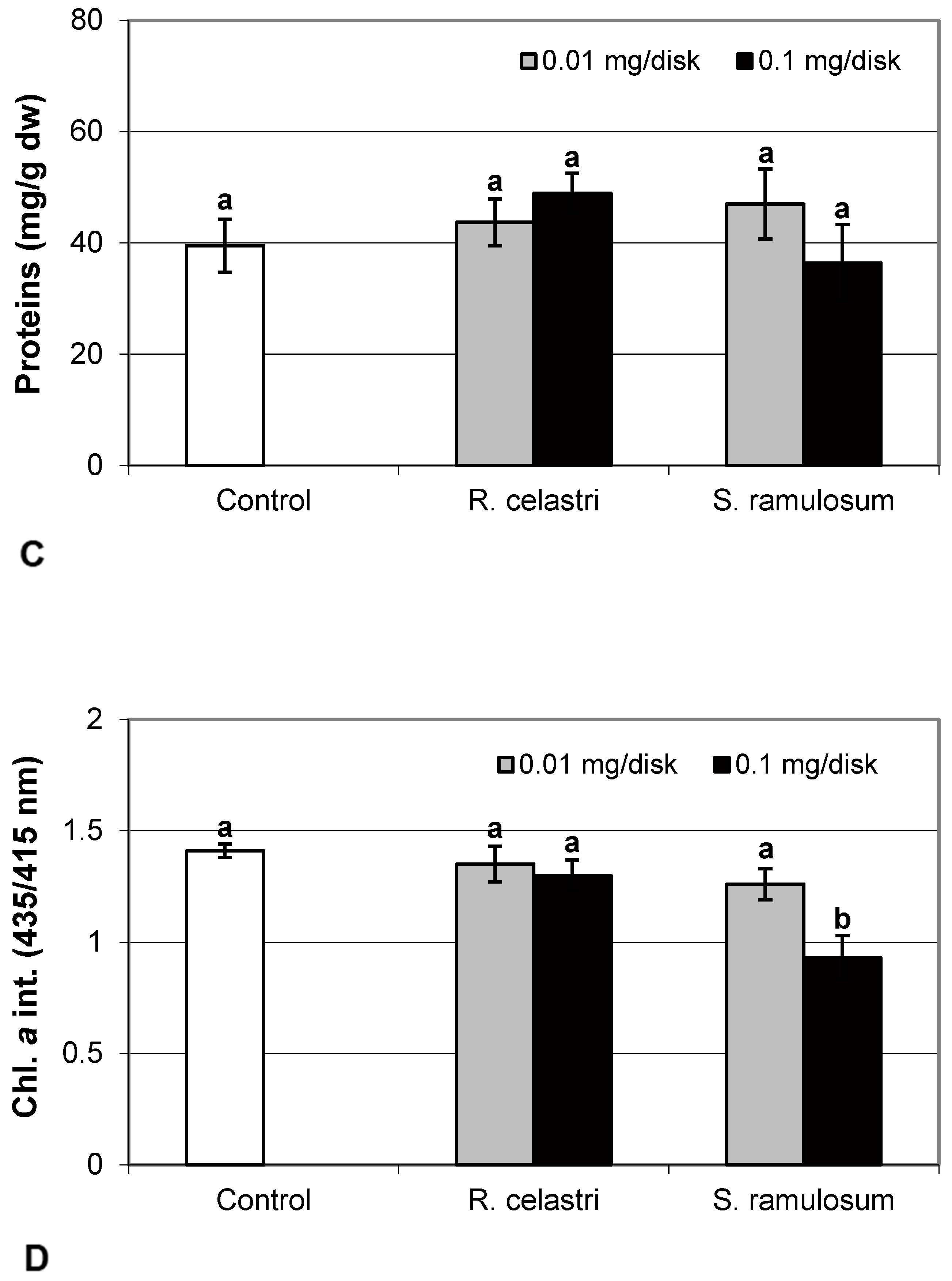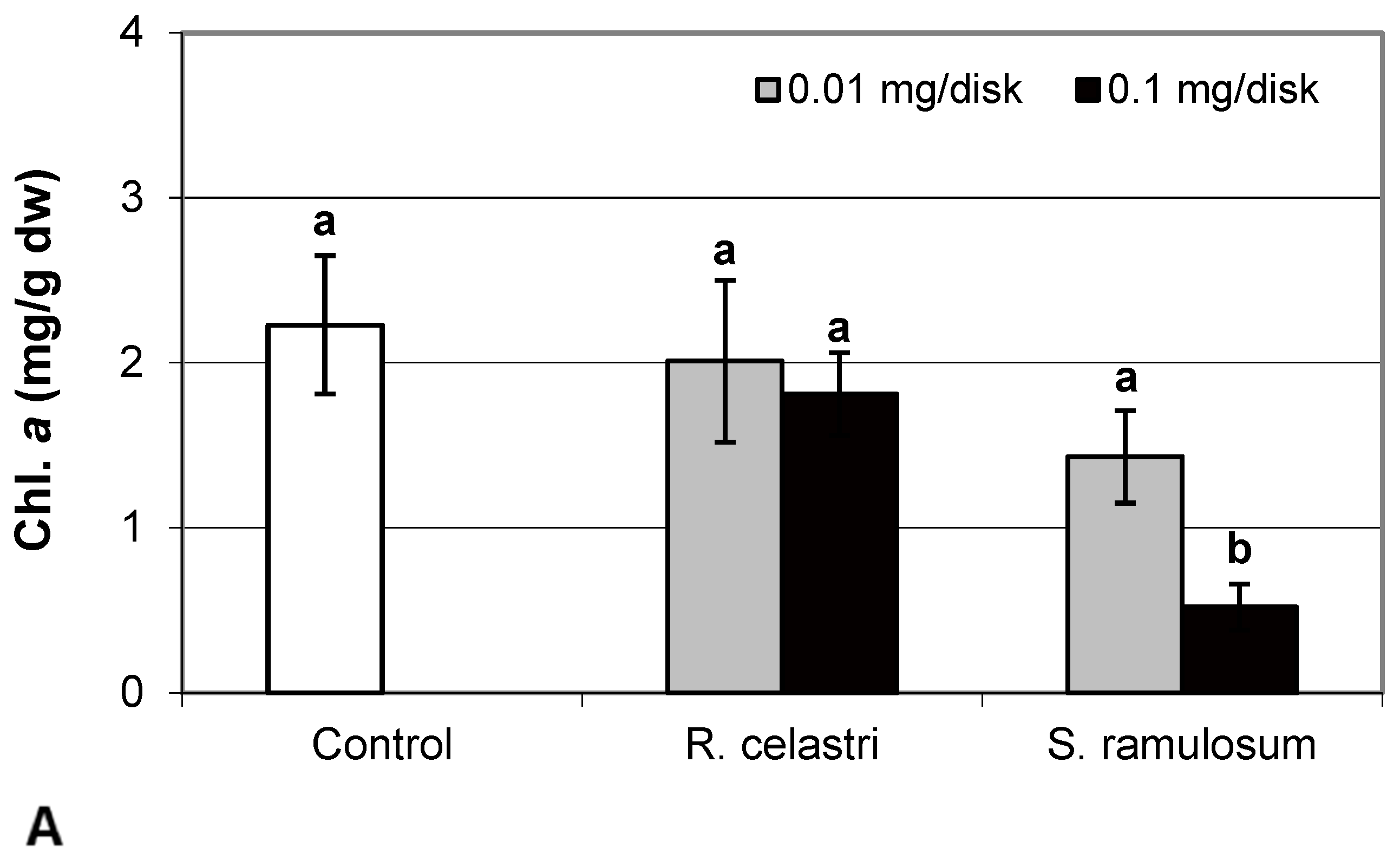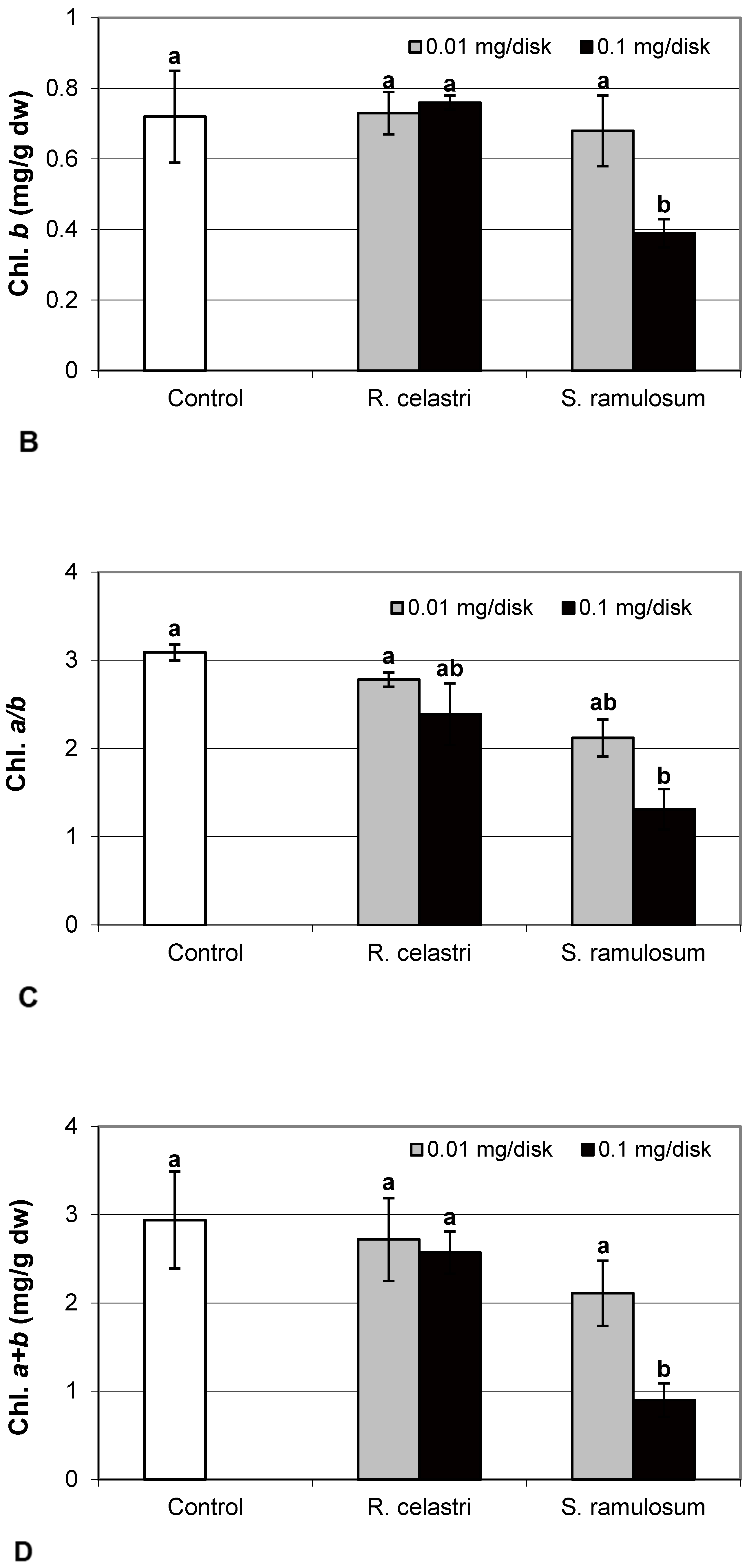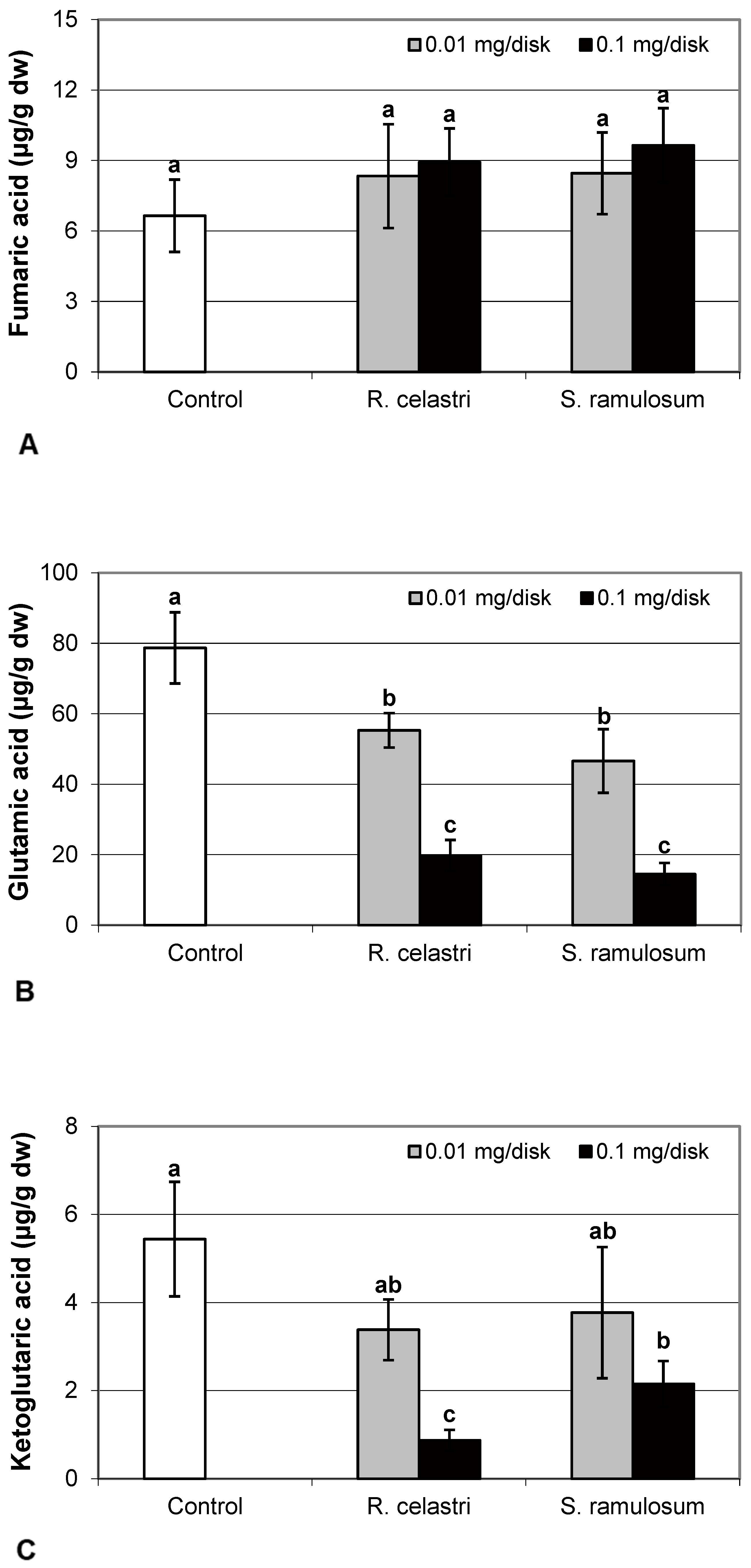Secondary Metabolites from Australian Lichens Ramalina celastri and Stereocaulon ramulosum Affect Growth and Metabolism of Photobiont Asterochloris erici through Allelopathy
Abstract
:1. Introduction
2. Results and Discussion
2.1. Photobiont Growth
2.2. Activity of Photosystem II, Soluble Proteins, and Content of Assimilation Pigments in Photobiont
2.3. Oxidative Status and Membrane Lipid Peroxidation in Photobiont
2.4. Production of Ascorbic Acid (AsA), Reduced (GSH) and Oxidized (GSSG) Glutathione
2.5. Photobiont Organic Acids
3. Materials and Methods
3.1. Organism, Culture Conditions, and Lichen Extracts
3.2. Allelopathic Assay
3.3. Assimilation Pigments and Chlorophyll a Integrity
3.4. Activity of Photosystem II
3.5. Content of Soluble Proteins
3.6. Oxidative Status
3.7. Membrane Lipid Peroxidation
3.8. Determination of Ascorbic Acid (AsA), Glutathione (GSH, GSSG) and Organic Acids
3.9. Statistical Analysis
4. Conclusions
Author Contributions
Funding
Institutional Review Board Statement
Informed Consent Statement
Data Availability Statement
Conflicts of Interest
Abbreviations
References
- Mark, K.; Laanisto, L.; Bueno, C.G.; Niinemets, U.; Keller, C.; Scheidegger, C. Contrasting co-occurrence patterns of photobiont and cystobasidiomycete yeast associated with common epiphytic lichen species. New Phytol. 2020, 227, 1362–1375. [Google Scholar] [CrossRef] [PubMed]
- Hawksworth, D.L.; Grube, M. Lichens redefined as complex ecosystems. New Phytol. 2020, 227, 1281–1283. [Google Scholar] [CrossRef] [PubMed]
- Bačkor, M.; Loppi, S. Interactions of lichens with heavy metals. Biol. Plant. 2009, 53, 214–222. [Google Scholar] [CrossRef]
- Lücking, R.; Leavitt, S.D.; Hawksworth, D.L. Species in lichen-forming fungi: Balancing between conceptual and practical considerations, and between phenotype and phylogenomics. Fungal Divers. 2021, 109, 99–154. [Google Scholar] [CrossRef]
- Goga, M.; Elečko, J.; Marcinčinová, M.; Ručová, D.; Bačkorová, M.; Bačkor, M. Lichen metabolites: An overview of some secondary metabolites and their biological potential. In Co-Evolution of Secondary Metabolites; Mérillon, J.M., Ramawat, K., Eds.; Springer: Cham, Switzerland, 2020; pp. 175–209. [Google Scholar]
- Xu, M.; Heiðmarsson, S.; Olafsdottir, E.S.; Buonfglio, R.; Kogej, T.; Omarsdottir, S. Secondary metabolites from cetrarioid lichens: Chemotaxonomy, biological activities and pharmaceutical potential. Phytomedicine 2016, 23, 441–459. [Google Scholar] [CrossRef]
- Elshobary, M.E.; Becker, M.G.; Kalichuk, J.L.; Chan, A.C.; Belmonte, M.F.; Piercey-Normore, M.D. Tissue-specific localization of polyketide synthase and other associated genes in the lichen, Cladonia rangiferina, using laser microdissection. Phytochemistry 2018, 156, 142–150. [Google Scholar] [CrossRef]
- Brodo, I.M.; Sharnoff, S.D.; Sharnoff, S. Lichens of North America; Yale University Press: New Haven, CT, USA, 2001. [Google Scholar]
- Smeds, A.I.; Kytöviita, M.M. Determination of usnic and perlatolic acids and identification of olivetoric acids in Northern reindeer lichen (Cladonia stellaris) extracts. Lichenologist 2010, 42, 739–749. [Google Scholar] [CrossRef]
- Cocchietto, M.; Skert, N.; Nimis, P.L.; Sava, G. A review on usnic acid, an interesting natural compound. Naturwissenschaften 2002, 89, 137–146. [Google Scholar] [CrossRef]
- Beckett, R.P.; Minibayeva, F.; Solhaug, K.A.; Roach, T. Photoprotection in lichens: Adaptations of photobionts to high light. Lichenologist 2021, 53, 21–33. [Google Scholar] [CrossRef]
- Solhaug, K.E.; Eiterjord, G.; Løken, M.H.; Gauslaa, Y. Non-photochemical quenching may contribute to the dominance of the pale mat-forming lichen Cladonia stellaris over the sympatric melanic Cetraria islandica. Oecologia 2024, 204, 187–198. [Google Scholar] [CrossRef]
- Bačkorová, M.; Bačkor, M.; Mikeš, J.; Jendželovský, R.; Fedoročko, P. Variable responses of different human cancer cells to the lichen compounds parietin, atranorin, usnic acid and gyrophoric acid. Toxicol. Vitro 2011, 25, 37–44. [Google Scholar] [CrossRef]
- Pizňak, M.; Kolarčik, V.; Goga, M.; Bačkor, M. Allelopathic effects of lichen metabolite usnic acid on growth and physiological responses of Norway spruce and Scots pine seedlings. S. Afr. J. Bot. 2019, 124, 14–19. [Google Scholar] [CrossRef]
- Goga, M.; Antreich, S.; Bačkor, M.; Weckwerth, W.; Lang, I. Lichen secondary metabolites affect growth of Physcomitrella patens by allelopathy. Protoplasma 2017, 254, 1307–1315. [Google Scholar] [CrossRef] [PubMed]
- Bačkor, M.; Klemová, K.; Bačkorová, M.; Ivanova, V. Comparison of the phytotoxic effects of usnic acid on cultures of free-living alga Scenedesmus quadricauda and aposymbiotically grown lichen photobiont Trebouxia erici. J. Chem. Ecol. 2010, 36, 405–411. [Google Scholar] [CrossRef] [PubMed]
- Kolackova, M.; Chaloupsky, P.; Cernei, N.; Klejdus, B.; Huska, D.; Adam, V. Lycorine and UV-C stimulate phenolic secondary metabolites production and miRNA expression in Chlamydomonas reinhardtii. J. Hazard. Mater. 2020, 391, 12208839. [Google Scholar] [CrossRef]
- Al-Bekairi, A.M.; Qureshi, S.; Chaudhry, M.A.; Krishna, D.R.; Shah, A.H. Mitodepressive, clastogenic and biochemical effects of (+)-usnic acid in mice. J. Ethnopharmacol. 1991, 33, 217–220. [Google Scholar] [CrossRef]
- Cardarelli, M.; Serino, G.; Campanella, L.; Ercole, P.; De Cicco Nardone, F.; Alesiani, O.; Rosiello, F. Antimitotic effects of usnic acid on different biological systems. Cell. Mol. Life Sci. 1997, 53, 667–672. [Google Scholar] [CrossRef]
- Endo, T.; Takahagi, T.; Kinoshita, Y.; Yamamoto, Y.; Sato, F. Inhibition of photosystem II of spinach by lichen-derived depsides. Biosci. Biotechnol. Biochem. 1998, 62, 2023–2027. [Google Scholar] [CrossRef]
- Takahagi, T.; Endo, T.; Yamamoto, Y.; Sato, F. Lichen photobionts show tolerance against lichen acids produced by lichen mycobionts. Biosci. Biotech. Bioch. 2008, 72, 3122–3127. [Google Scholar] [CrossRef]
- Váczi, P.; Gauslaa, Y.; Solhaug, K.A. Efficient fungal UV-screening provides a remarkably high UV-B tolerance of photosystem II in lichen photobionts. Plant Physiol. Biochem. 2018, 132, 89–94. [Google Scholar] [CrossRef]
- Barták, M.; Hájek, J.; Halici, M.G.; Bednaříková, M.; Casanova-Katny, A.; Váczi, P.; Puhovkin, A.; Mishra, K.B.; Giordano, D. Resistance of primary photosynthesis to photoinhibition in Antarctic lichen Xanthoria elegans: Photoprotective mechanisms activated during a short period of high light stress. Plants 2023, 12, 2259. [Google Scholar] [CrossRef]
- Rapsch, S.; Ascaso, C. Effect of evernic acid on structure of spinach chloroplasts. Ann. Bot-London 1985, 56, 467–473. [Google Scholar] [CrossRef]
- Bačkor, M.; Goga, M.; Ručová, D.; Urminská, D.; Bačkorová, M.; Klejdus, B. Allelopathic effects of three lichen secondary metabolites on cultures of aposymbiotically grown lichen photobionts and free-living alga Scenedesmus quadricauda. S. Afr. J. Bot. 2023, 162, 688–693. [Google Scholar] [CrossRef]
- Han, D.; Matsumaru, K.; Rettori, D.; Kaplowitz, N. Usnic acid-induced necrosis of cultured mouse hepatocytes: Inhibition of mitochondrial function and oxidative stress. Biochem. Pharmacol. 2004, 67, 439–451. [Google Scholar] [CrossRef]
- Caviglia, A.M.; Nicora, P.; Giordani, P.; Brunialti, G.; Modenesi, P. Oxidative stress and usnic acid content in Parmelia caperata and Parmelia soredians (Lichenes). Farmaco 2001, 56, 379–382. [Google Scholar] [CrossRef] [PubMed]
- Bačkorová, M.; Jendželovský, R.; Kello, M.; Bačkor, M.; Mikeš, J.; Fedoročko, P. Lichen secondary metabolites are responsible for induction of apoptosis in HT-29 and A2780 human cancer cell lines. Toxicol. Vitro 2012, 26, 462–468. [Google Scholar] [CrossRef] [PubMed]
- Sun, X.M.; Lu, Z.Y.; Liu, B.Y.; Zhou, Q.H.; Zhang, Y.Y.; Wu, Z.B. Allelopathic effects of pyrogallic acid secreted by submerged macrophytes on Microcystis aeruginosa: Role of ROS generation. Allelopath. J. 2014, 33, 121–130. [Google Scholar]
- Li, H.; Zhou, X.; Huang, Y.; Liao, B.; Cheng, L.; Ren, B. Reactive oxygen species in pathogen clearance: The killing mechanisms, the adaption response, and the side effects. Front. Microbiol. 2020, 11, 622534. [Google Scholar]
- Elečko, J.; Vilková, M.; Frenák, R.; Routray, D.; Ručová, D.; Bačkor, M.; Goga, M. A Comparative Study of Isolated Secondary Metabolites from Lichens and Their Antioxidative Properties. Plants 2022, 11, 1077. [Google Scholar] [CrossRef]
- Wellburn, A.R. The spectral determination of chlorophylls a and b, as well as total carotenoids, using various solvents with spectrophotometers of different resolutions. J. Plant Physiol. 1994, 144, 307–313. [Google Scholar] [CrossRef]
- Lokajová, V.; Bačkorová, M.; Bačkor, M. Allelopathic effects of lichen secondary metabolites and their naturally occurring mixtures on cultures of aposymbiotically grown lichen photobiont Trebouxia erici (Chlorophyta). S. Afr. J. Bot. 2014, 93, 86–91. [Google Scholar] [CrossRef]
- Bradford, M.M. Rapid and sensitive method for quantitation of microgram quantities of protein utilizing principle of protein-dye binding. Anal. Biochem. 1976, 72, 248–254. [Google Scholar] [CrossRef] [PubMed]
- Bačová, R.; Klejdus, B.; Ryant, P.; Cernei, N.; Adam, V.; Húska, D. The effects of 5-azacytidine and cadmium on global 5-methylcytosine content and secondary metabolites in the freshwater microalgae Chlamydomonas reinhardtii and Scenedesmus quadricauda. J. Phycol. 2019, 55, 329–342. [Google Scholar] [CrossRef] [PubMed]














Disclaimer/Publisher’s Note: The statements, opinions and data contained in all publications are solely those of the individual author(s) and contributor(s) and not of MDPI and/or the editor(s). MDPI and/or the editor(s) disclaim responsibility for any injury to people or property resulting from any ideas, methods, instructions or products referred to in the content. |
© 2024 by the authors. Licensee MDPI, Basel, Switzerland. This article is an open access article distributed under the terms and conditions of the Creative Commons Attribution (CC BY) license (https://creativecommons.org/licenses/by/4.0/).
Share and Cite
Bačkor, M.; Kecsey, D.; Drábová, B.; Urminská, D.; Šemeláková, M.; Goga, M. Secondary Metabolites from Australian Lichens Ramalina celastri and Stereocaulon ramulosum Affect Growth and Metabolism of Photobiont Asterochloris erici through Allelopathy. Molecules 2024, 29, 4620. https://doi.org/10.3390/molecules29194620
Bačkor M, Kecsey D, Drábová B, Urminská D, Šemeláková M, Goga M. Secondary Metabolites from Australian Lichens Ramalina celastri and Stereocaulon ramulosum Affect Growth and Metabolism of Photobiont Asterochloris erici through Allelopathy. Molecules. 2024; 29(19):4620. https://doi.org/10.3390/molecules29194620
Chicago/Turabian StyleBačkor, Martin, Dajana Kecsey, Blažena Drábová, Dana Urminská, Martina Šemeláková, and Michal Goga. 2024. "Secondary Metabolites from Australian Lichens Ramalina celastri and Stereocaulon ramulosum Affect Growth and Metabolism of Photobiont Asterochloris erici through Allelopathy" Molecules 29, no. 19: 4620. https://doi.org/10.3390/molecules29194620
APA StyleBačkor, M., Kecsey, D., Drábová, B., Urminská, D., Šemeláková, M., & Goga, M. (2024). Secondary Metabolites from Australian Lichens Ramalina celastri and Stereocaulon ramulosum Affect Growth and Metabolism of Photobiont Asterochloris erici through Allelopathy. Molecules, 29(19), 4620. https://doi.org/10.3390/molecules29194620







